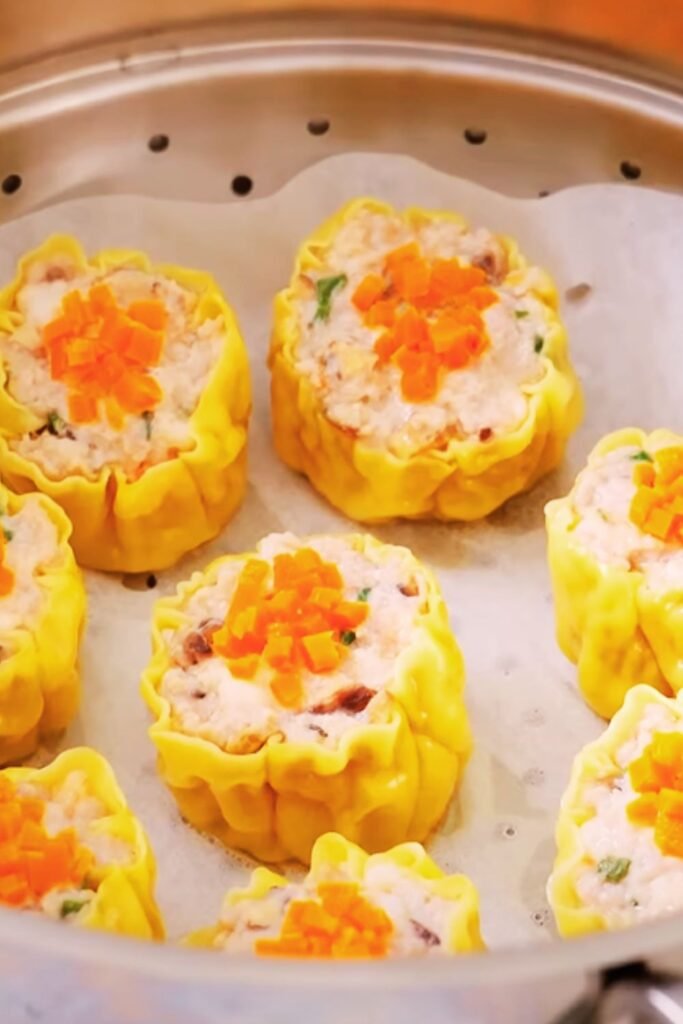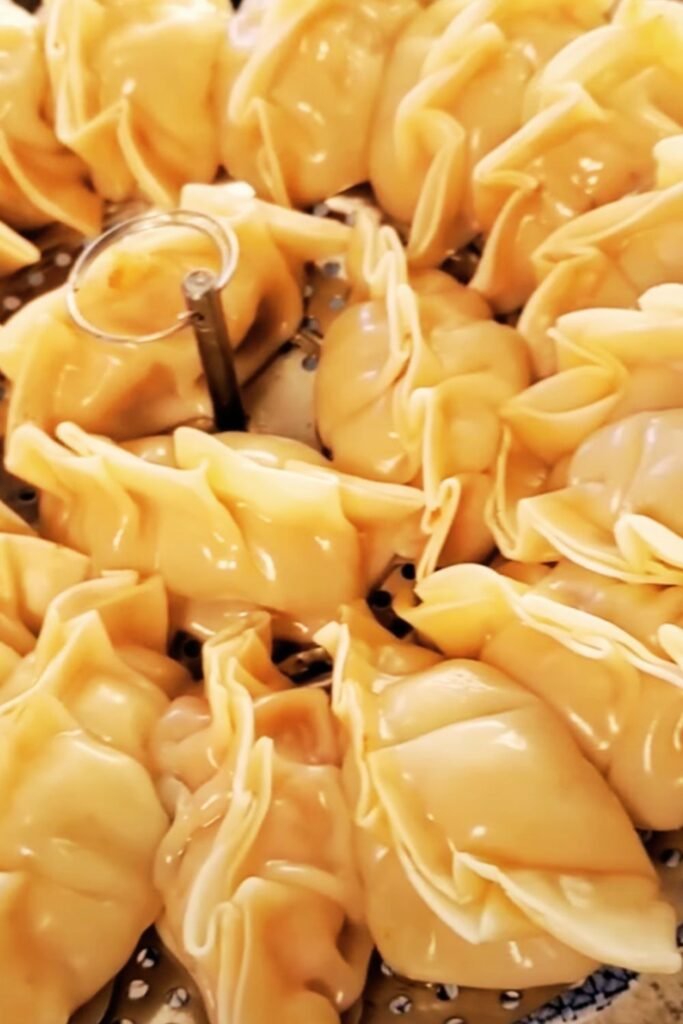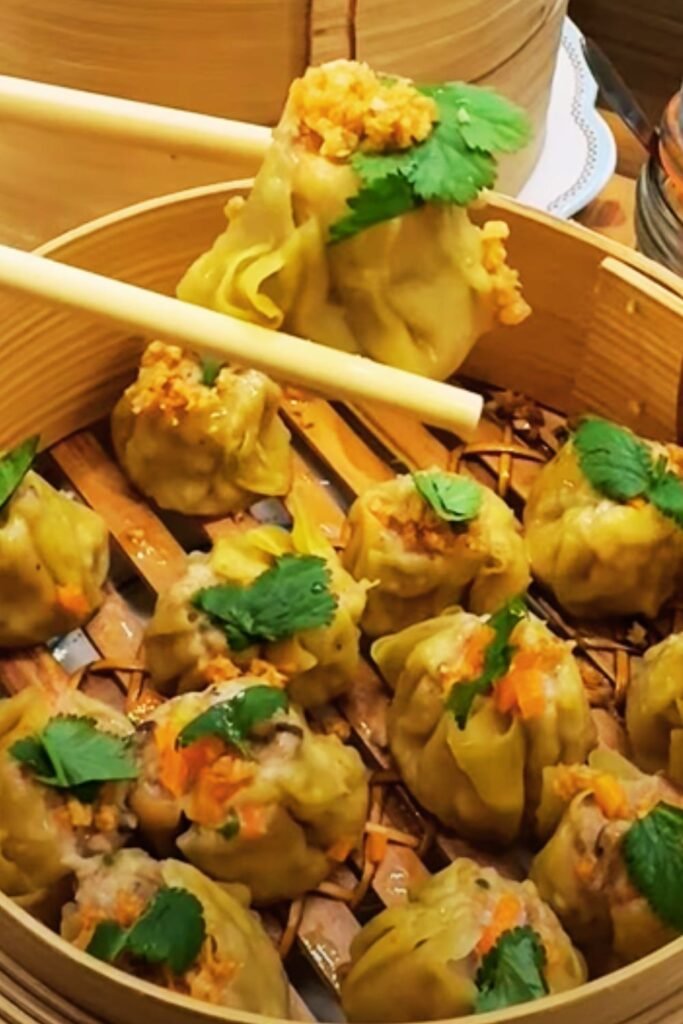There’s something magical about biting into a perfectly steamed dumpling. That moment when the delicate wrapper gives way to reveal a burst of aromatic filling is nothing short of culinary bliss. Today, I’m excited to share my favorite recipe for Steamed Thai Pork Dumplings – a dish that brings the vibrant flavors of Thailand to your dinner table through the beloved Chinese dim sum tradition.
As someone who has spent countless hours perfecting these little pockets of joy, I can promise you that despite their impressive appearance, they’re surprisingly approachable to make at home. The combination of tender pork, fragrant Thai herbs, and delicate wrappers creates an explosion of flavor that will transport you straight to the bustling street markets of Bangkok.
Whether you’re hosting a dinner party or simply craving something special for a weekend project, these dumplings deliver restaurant-quality results without requiring professional skills. Let me walk you through everything you need to know to create these delicious morsels from scratch.
What Makes These Dumplings Special
Traditional Chinese dumplings get a magnificent Thai makeover in this fusion recipe. While maintaining the beloved dim sum format, these dumplings incorporate quintessential Thai ingredients that create a unique flavor profile:
- Lemongrass: Adds a subtle citrusy note that brightens the filling
- Fish sauce: Provides that unmistakable umami depth and authentic Thai flavor
- Thai basil: Offers aromatic complexity with its anise-like quality
- Bird’s eye chilies: Delivers the perfect amount of heat to balance the richness
The result is a dumpling that honors both culinary traditions while creating something entirely new. The steaming process ensures the meat stays tender and juicy while allowing the wrapper to maintain that perfect soft-yet-slightly-chewy texture that dumpling aficionados crave.
Essential Ingredients
For the Dumpling Filling:
- 1 pound (450g) ground pork (preferably not too lean, about 80/20 fat ratio)
- 3 tablespoons finely minced lemongrass (white part only)
- 4 cloves garlic, finely minced
- 2 shallots, finely diced
- 2 tablespoons fish sauce
- 1 tablespoon light soy sauce
- 1 teaspoon palm sugar or brown sugar
- 1-2 bird’s eye chilies, finely chopped (adjust to your heat preference)
- ¼ cup finely chopped Thai basil leaves
- 2 tablespoons chopped cilantro stems and leaves
- 1 tablespoon neutral oil (like vegetable or canola)
- 1 teaspoon white pepper
- 1 teaspoon sesame oil
For the Wrappers:
- 40-45 round dumpling wrappers (store-bought or homemade)
- Small bowl of water (for sealing)
For the Dipping Sauce:
- 3 tablespoons fish sauce
- 2 tablespoons lime juice
- 1 tablespoon water
- 1 teaspoon palm sugar or brown sugar
- 1 clove garlic, finely minced
- 1 bird’s eye chili, thinly sliced
- 1 tablespoon chopped cilantro
Kitchen Equipment You’ll Need
Before diving into the preparation, make sure you have these tools on hand:
- Large mixing bowl
- Cutting board and sharp knife
- Steamer basket and pot (bamboo steamer works best)
- Small bowl for water (to seal dumplings)
- Measuring spoons and cups
- Parchment paper or cabbage leaves (to line steamer)
- Clean kitchen towel
- Small bowl for dipping sauce

Step-by-Step Preparation
Preparing the Filling
- Prepare the aromatics: Finely mince the lemongrass, garlic, and shallots. The finer you chop these ingredients, the better texture your filling will have.
- Mix the filling: In a large bowl, combine the ground pork with all the filling ingredients: lemongrass, garlic, shallots, fish sauce, soy sauce, palm sugar, chilies, Thai basil, cilantro, oil, white pepper, and sesame oil.
- Develop the flavors: Using clean hands, mix everything thoroughly until well combined. Work the mixture for about 2-3 minutes, stirring in one direction to develop a sticky texture that will hold together well when cooked.
- Rest the filling: Cover the bowl with plastic wrap and refrigerate for at least 30 minutes (or up to 4 hours) to allow the flavors to meld together. This resting time makes a significant difference in the final taste.
Folding the Dumplings
- Set up your workspace: Create a dumpling assembly station with your filling, stack of wrappers, small bowl of water, and a clean plate or tray for the finished dumplings.
- Fill the wrappers: Take one wrapper and place it flat on your palm. Add about 1 tablespoon of filling to the center of the wrapper. Be careful not to overfill, as this can cause the dumplings to burst during cooking.
- Moisten the edges: Dip your finger in water and run it along the outer edge of half the wrapper to create a seal.
- Shape the dumplings: There are several ways to fold dumplings, but here’s a simple pleating method:
- Fold the wrapper in half over the filling to create a half-moon shape
- Starting from one end, create small pleats along the edge, pressing firmly to seal
- Aim for 4-5 pleats along the curved edge
- Make sure the dumpling is completely sealed to prevent the filling from leaking
- Place on tray: Set the folded dumpling on a plate or tray, making sure they don’t touch each other to prevent sticking.
- Repeat: Continue this process until all the filling is used up. This recipe should yield approximately 40-45 dumplings.
Steaming the Dumplings
- Prepare your steamer: Line your steamer basket with parchment paper with small holes punched in it or cabbage leaves to prevent sticking. If using a bamboo steamer, soak it in water for 20 minutes before using to prevent burning.
- Arrange the dumplings: Place the dumplings in the steamer, leaving about 1 inch between each to allow for expansion. Avoid overcrowding.
- Steam in batches: Bring water to a boil in your steaming pot, then place the steamer basket with dumplings over the boiling water. Cover with a lid.
- Cook thoroughly: Steam for 8-10 minutes until the wrappers are translucent and the filling is cooked through. The internal temperature should reach 165°F (74°C).
- Keep warm: If cooking in multiple batches, keep the cooked dumplings covered with a clean kitchen towel to stay warm.
Preparing the Dipping Sauce
While the dumplings are steaming, prepare the dipping sauce:
- In a small bowl, combine fish sauce, lime juice, water, and palm sugar, stirring until the sugar dissolves.
- Add the minced garlic, sliced chili, and chopped cilantro.
- Let the sauce sit for at least 5 minutes before serving to allow the flavors to blend.
How to Serve Your Thai Pork Dumplings
For an authentic dim sum experience, serve your steaming hot dumplings immediately after cooking. Here are some serving suggestions:
- Transfer the dumplings to a serving plate and garnish with additional chopped cilantro and Thai basil
- Serve the dipping sauce in small individual bowls for each person
- Accompany with a side of stir-fried Asian greens like bok choy or gai lan
- Complete the meal with steamed jasmine rice for a more substantial offering
- For a full dim sum spread, pair with other favorites like spring rolls or sticky rice in lotus leaf

Nutritional Information
Each serving of 5 dumplings provides:
| Nutrient | Amount |
|---|---|
| Calories | 290 |
| Protein | 18g |
| Carbohydrates | 30g |
| Fat | 12g |
| Fiber | 2g |
| Sodium | 890mg |
| Sugar | 3g |
Variations and Substitutions
One of the joys of making dumplings is how versatile they are. Here are some ways to adapt this recipe:
Protein Options:
- Chicken: Substitute ground chicken for a lighter dumpling
- Shrimp: Add finely chopped shrimp for a seafood variation
- Tofu: Create a vegetarian version using crumbled firm tofu (make sure to press out excess moisture)
Wrapper Alternatives:
- Rice paper: For a gluten-free option, use rice paper wrappers (these will need to be briefly soaked in water)
- Homemade wrappers: Make your own using a simple flour and water dough
- Wonton wrappers: These are thinner but work well if dumpling wrappers aren’t available
Regional Variations:
- Northern Thai style: Add a tablespoon of fermented soybean paste to the filling for a distinctive flavor
- Southern Thai twist: Incorporate a tablespoon of red curry paste for a spicier profile
- Isaan influence: Include some toasted rice powder for texture and nutty flavor
Make-Ahead and Storage Tips
Dumplings are perfect for meal prep and can be prepared in advance in several ways:
Freezing Uncooked Dumplings:
- Place the freshly folded dumplings on a parchment-lined baking sheet, ensuring they don’t touch.
- Freeze until solid (about 2 hours).
- Transfer to airtight containers or freezer bags.
- Label with the date and store for up to 3 months.
- Cook directly from frozen, adding 2-3 minutes to the steaming time.
Storing Cooked Dumplings:
- Refrigerate in an airtight container for up to 2 days.
- Reheat by steaming for 2-3 minutes until thoroughly hot.
Storing the Filling:
- The filling mixture can be refrigerated for up to 24 hours before forming dumplings.
- This actually improves the flavor as the aromatics have more time to infuse.
Troubleshooting Common Issues
Even experienced dumpling makers encounter challenges. Here’s how to solve them:
| Problem | Cause | Solution |
|---|---|---|
| Dumplings sticking to steamer | Not using a liner | Line with parchment paper or cabbage leaves |
| Filling leaking out | Overfilling or poor sealing | Use less filling and ensure edges are properly sealed |
| Doughy texture | Undercooked | Steam for additional 1-2 minutes |
| Tough wrapper | Overcooked | Reduce steaming time slightly |
| Bland filling | Insufficient seasoning | Taste test the filling by cooking a small amount before making all dumplings |
| Wrappers drying out | Exposure to air | Keep wrappers covered with a damp towel while working |
Why This Recipe Works
The success of these Thai pork dumplings comes down to a few key principles:
- Balanced flavor profile: The combination of aromatic lemongrass, pungent fish sauce, and fresh herbs creates layers of flavor that develop during cooking.
- Proper texture: The technique of mixing the filling in one direction helps develop proteins that give the filling a springy, tender texture rather than a dense, heavy one.
- Steaming method: Steaming keeps the dumplings juicy and allows the subtle flavors to shine through without the interference that frying or boiling might introduce.
- Complementary dipping sauce: The tangy, savory sauce cuts through the richness of the pork and enhances the Thai flavor profile.

Frequently Asked Questions
Can I make these dumplings gluten-free?
Yes! You can use rice flour wrappers or make your own gluten-free wrappers using a combination of rice flour and tapioca starch. The filling itself contains no gluten as long as you use a gluten-free soy sauce.
How spicy are these dumplings?
With the recipe as written, they have a moderate heat level. You can easily adjust by changing the number of bird’s eye chilies in both the filling and dipping sauce. For a milder version, remove the seeds from the chilies or substitute with bell pepper for flavor without heat.
Can I pan-fry these instead of steaming?
Absolutely! While steaming gives the most authentic texture for this Thai-style dumpling, you can certainly pan-fry them to create potstickers. Heat oil in a non-stick pan, arrange dumplings flat-side down, cook until golden on the bottom, then add ¼ cup water, cover, and steam until the water evaporates.
Where can I find dumpling wrappers?
Most Asian grocery stores carry dumpling wrappers in the refrigerated section. Look for round “gyoza” or “dumpling” wrappers rather than square wonton wrappers (though those can work in a pinch). Some mainstream supermarkets also carry them in the international foods section.
How can I tell when the dumplings are fully cooked?
The wrappers will become translucent rather than opaque, and the filling will be firm when gently pressed. If you’re uncertain, you can always cut one open to check – the pork should be fully cooked with no pink remaining.
Can I make the dipping sauce in advance?
Yes, the dipping sauce can be made up to 24 hours ahead and stored in the refrigerator. The flavors will actually improve as they meld together. Just give it a quick stir before serving.
Tips for Perfect Dumplings Every Time
After years of making these delightful Thai pork dumplings, I’ve gathered some professional tips that make a huge difference:
- Keep wrappers moist: Cover your stack of wrappers with a damp paper towel while working to prevent them from drying out.
- Test your filling: Before wrapping all your dumplings, cook a small amount of filling in a microwave or pan to taste for seasoning. It’s much easier to adjust flavors now than after all the dumplings are wrapped.
- Don’t rush the folding: Take your time with the pleating process. Well-sealed dumplings not only look more beautiful but also cook more evenly.
- Watch the steam: Never lift the steamer lid during cooking as the rush of escaping steam can cause the wrappers to wrinkle and toughen.
- Serve immediately: Dumplings wait for no one! They’re at their absolute best fresh from the steamer, so have your table set and guests ready before the final batch is done.
The Cultural Significance of Dumplings
Dumplings hold a special place in many Asian cultures, representing togetherness and prosperity. In Chinese tradition, families gather to make dumplings before the Lunar New Year, with the shape symbolizing ancient gold ingots – a wish for wealth in the coming year.
This Thai-inspired version represents the beautiful culinary exchange that happens across Asian cultures, where techniques and presentations are shared while regional flavors remain distinct. By bringing these two culinary traditions together, we create something that honors both while offering something new and exciting.
Whether you’re making these for a special occasion or simply to enjoy a delicious meal, there’s something deeply satisfying about creating these little parcels of flavor. The process itself – from mixing the aromatic filling to the meditative practice of folding each dumpling – is as rewarding as the final result.
I hope these Thai Pork Dumplings bring as much joy to your table as they have to mine!
Q&A Section
Is it worth making my own dumpling wrappers or should I buy them?
While homemade wrappers have a wonderful texture and can be quite satisfying to make, store-bought wrappers are perfectly acceptable and save considerable time. If you’re new to dumpling making, I recommend starting with store-bought wrappers to focus on mastering the filling and folding techniques. Once you’re comfortable with the process, you might enjoy experimenting with homemade wrappers.
What’s the best way to serve these for a party?
For entertaining, consider setting up a steaming station where you can cook the dumplings in batches as needed. Keep a bamboo steamer going throughout the event, bringing fresh dumplings out every 10 minutes or so. This creates a fun, interactive dining experience and ensures everyone gets to taste the dumplings at their peak freshness. Prepare plenty of dipping sauce in advance and have small individual bowls ready for each guest.
Can I prepare everything the day before a dinner party?
Yes! This is actually an ideal make-ahead dish. Prepare and fold all your dumplings the day before, arranging them on parchment-lined baking sheets with space between each. Freeze until solid, then transfer to freezer bags. The dipping sauce can also be made a day ahead and refrigerated. On the day of your party, you can steam the dumplings directly from frozen, adding just 2-3 minutes to the cooking time.
How important is it to use Thai basil specifically?
Thai basil has a distinctive anise-like flavor that really complements the other Thai ingredients in this recipe. If you can’t find it, regular Italian basil will work but will give a slightly different flavor profile. In a pinch, you could substitute a combination of regular basil and a small amount of mint to approximate the complexity of Thai basil.
What should I do with leftover filling or wrappers?
Leftover filling can be formed into small meatballs and steamed or pan-fried, then served with the dipping sauce as an appetizer. Alternatively, use it as a filling for lettuce wraps or to top rice bowls. Extra wrappers can be cut into strips and fried until crispy for a crunchy garnish for soups or salads, or wrapped around small pieces of chocolate for a quick dessert dumpling.